Who illustrated the Enid Blyton books? Was it Beatrix Potter?
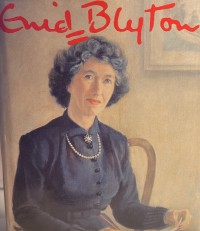
This question recently posted on a Facebook group I am involved met with derision from some, but prompted a flurry of responses which got me thinking about the large number of artists linked with Enid Blyton’s work.
The questioner had confused two of the great English female storytellers of the 20th century. Beatrix Potter never illustrated any of Enid Blyton’s books, in fact Peter Rabbit was first published when Blyton was just five years old. By the time Blyton’s earliest books were published Potter was immersed in sheep farming in the English Lake District and she died in 1943, a year after publication of the first Famous Five adventure.
Some authors seem inextricably linked with one specific illustrator, a perfect collision of words and imagery, think Roald Dahl and Quentin Blake or Julia Donaldson and Axel Scheffler. But Blyton’s career spanned five decades and she steadily progressed from being a minor poet and contributor of short stories for periodicals and annuals to a block busting author, who could pick and choose her artist according to the theme of her writing. Like Potter, Blyton had strong views about how best to present her works, but the abundance of her output left her with little time to obsess over the finer details.
To attempt a catalogue of all of the illustrators who worked with Blyton over her long and prolific career would make for a rather lengthy post, so taking my lead from Blyton herself I enlisted the help of my daughter who gave me a list of her favourite Blyton books or series (Thanks Annie! ) and below are details of the illustrators that helped beguile her and thousands of other children.
Early Years
In her twenties Blyton worked as a primary school teacher and struggling to find poems of the type that really engaged her young pupils she set about writing her own.
“I have found the children delight in two distinct types of verses. These are the humorous type and the imaginative poetical type- the humour must be from a child’s point of view and not from a ‘grown-ups’ - a very different thing. And the imagination in the second type of poem must be clear and whimsical, otherwise the appeal fails.”
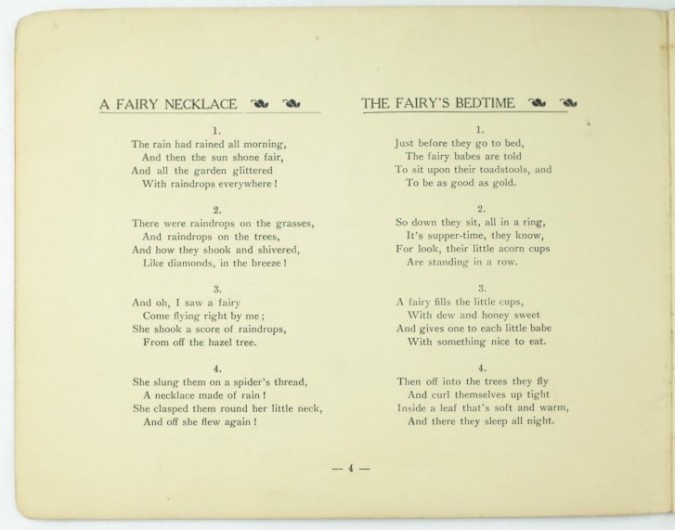
Thus her first two books, Child Whispers, published in 1922 and Real Fairies, 1923, were little volumes of verses in a whimsical style, similar to those that would follow a year later in A.A. Milne’s When We Were Very Young. The books had a pictorial covers drawn by Blyton’s old school friend, Phyllis Chase.
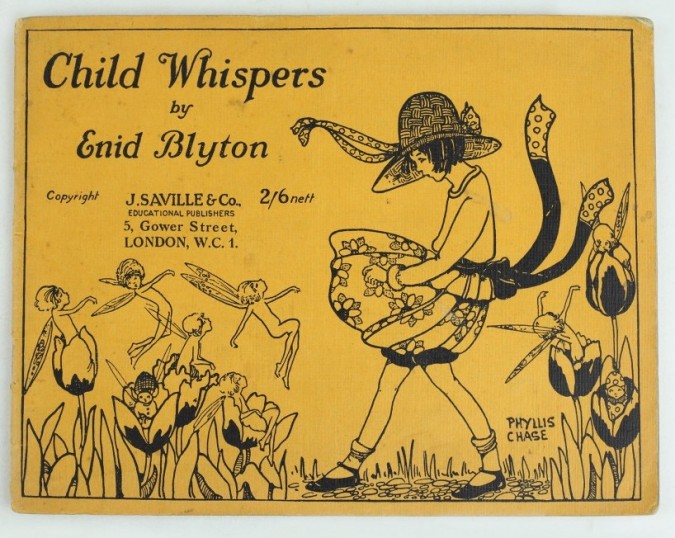
Child Whispers, with cover artwork by Blyton's school friend, Phyllis Chase
As the 1920’s progressed Blyton’s income from writing increased steadily. She regularly had stories and poems published in periodicals such as Teacher’s World, Punch and Women’s Life. And over the decade it became apparent that she had a real talent for writing stories which captured the imagination of children. The plots were tested out firstly on her pupils and later on her own children, she found that boys liked cowboys and girls preferred fairies, while both loved adventure, mystery and animal tales.
Book of Fairies and Land of Far Beyond - Lola Onslow and Horace Knowles
In 1924 Blyton’s relationship with Newnes publishing house (andwith one of their editors Major Hugh Pollock, who would quickly become her husband) was established with her publication of The Enid Blyton Book of Fairies, a delightful collection of fantasy tales whose vibrant cover and frontispiece were drawn by Lola Onslow, but whose internal drawings by Horace J. Knowles Blyton admired tremendously.
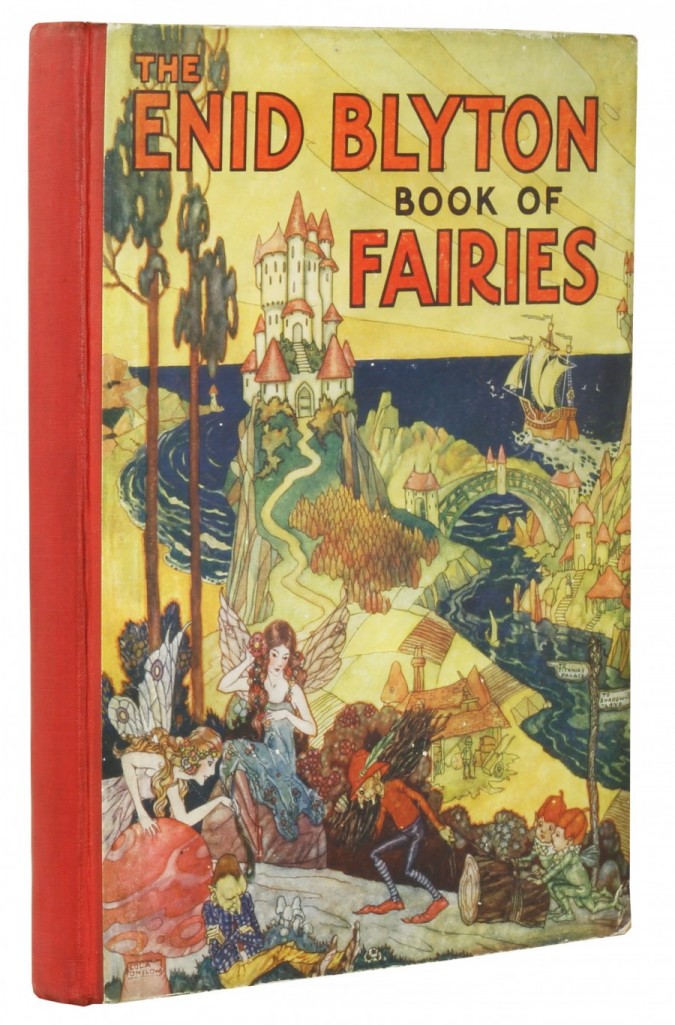
Lola Onslow's colourful cover design for Enid Blyton's Book of Fairies
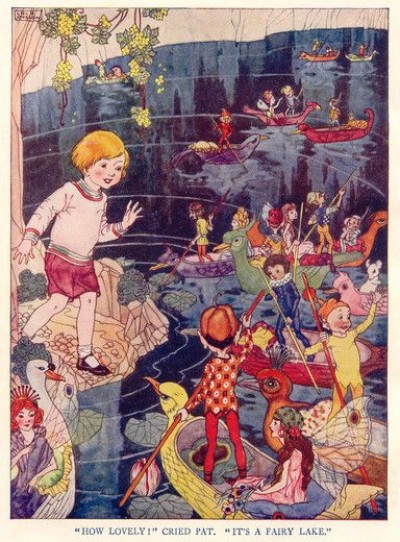 Lola Onslow Frontispiece for Book Of Fairies
Lola Onslow Frontispiece for Book Of Fairies
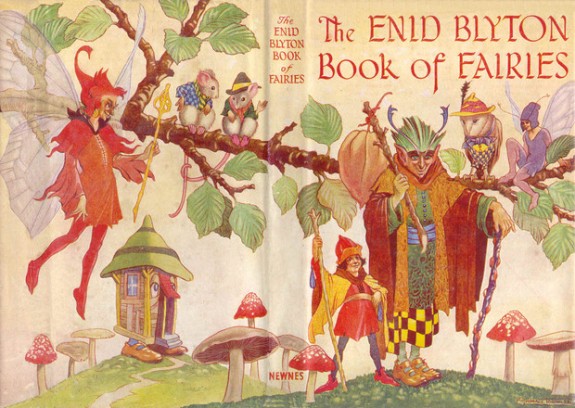
Horace Knowles dustjacket for Blyton's Book of Fairies
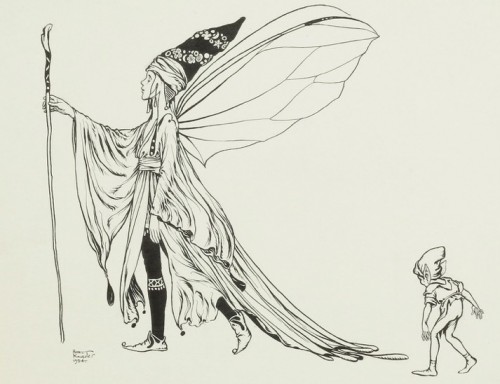
Knowles' line drawing from Blyton's Book of Fairies
Knowles produced illustrations for many of Blyton’s magazine stories, provided a colourful Deco style design for a 1949 reissue of the Book of Fairies and was her first choice of illustrator for her 1942 Pilgrim’s Progress style book, The Land of Far Beyond. Whilst Knowles’ colour work is appealing, his great strength lay in his use of black and white, employing the use of a pattern of delicate dots to breathe life into gossamer fairy wings combined with large areas of dense, black ink used to dramatic effect.
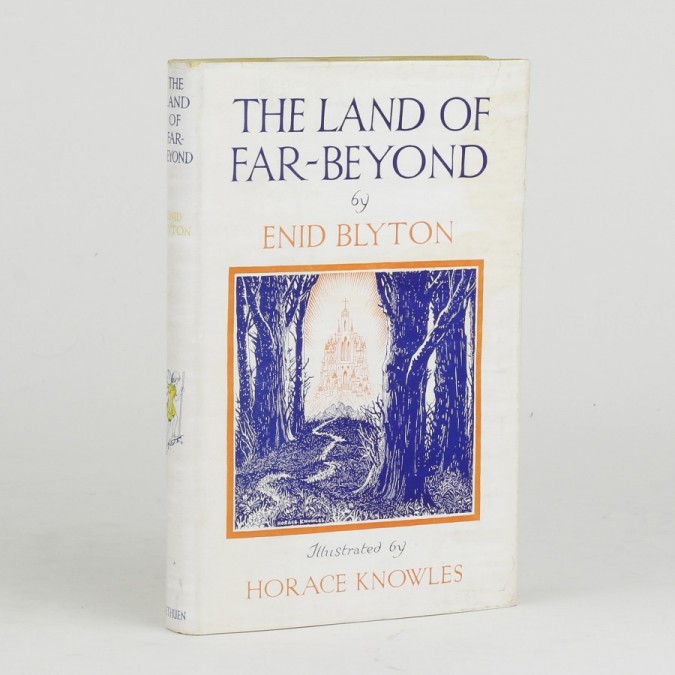
Dustjacket for 1942 first edition Land of Far Beyond
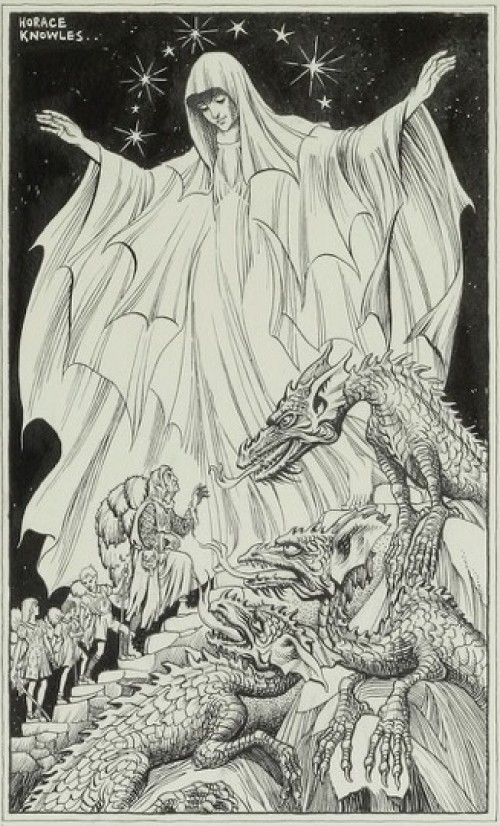
Knowles' drawings from Land of Far Beyond, chapter 11
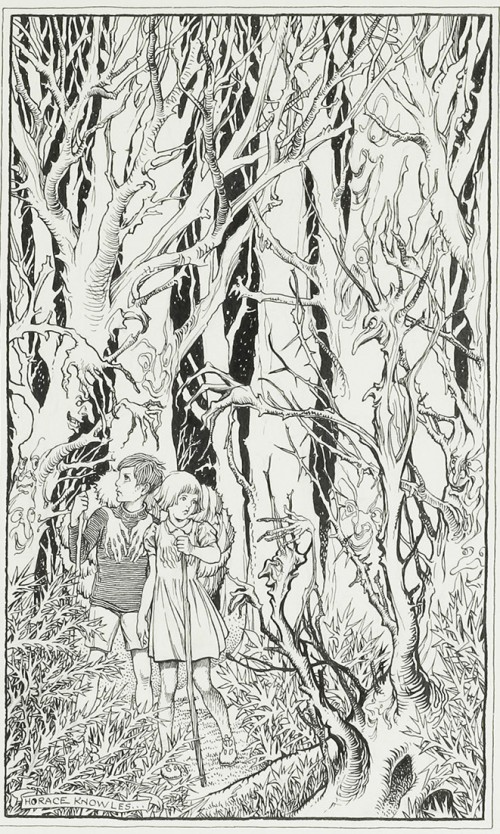
Knowles' drawings from Land of Far Beyond, chapter 7
The Faraway Tree Books – Dorothy Wheeler
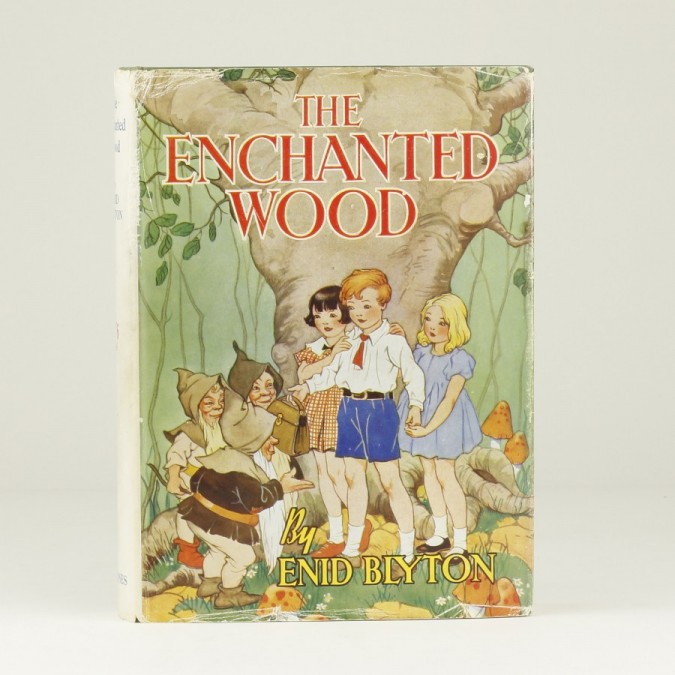
First edition of the Enchanted Wood, 1939
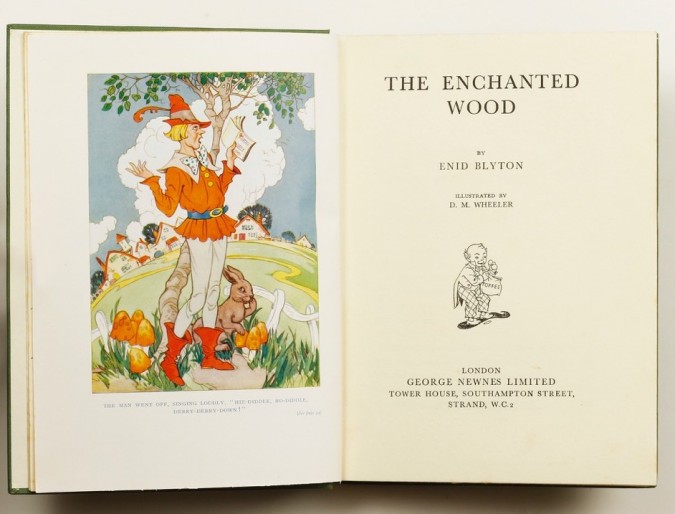
Title page and colour frontis by Dorothy Wheeler
Newnes published many of Blyton’s most loved works, including in 1939 The Enchanted Wood and other books in the Magic Faraway Tree Series. Drawings for these were provided by Dorothy Wheeler and Blyton particularly loved the wraparound dustwrappers, with one scene spread over both covers and spine, for The Magic Faraway Tree and the Folk of the Faraway Tree, which she believed, “give an artist a chance to get at the heart of a book and display it on its jacket.”Wheeler’s drawings add just the right amount of humour into the colorful inhabitants the Magic Tree, at the top of which magical lands appear – and disappear - without warning.
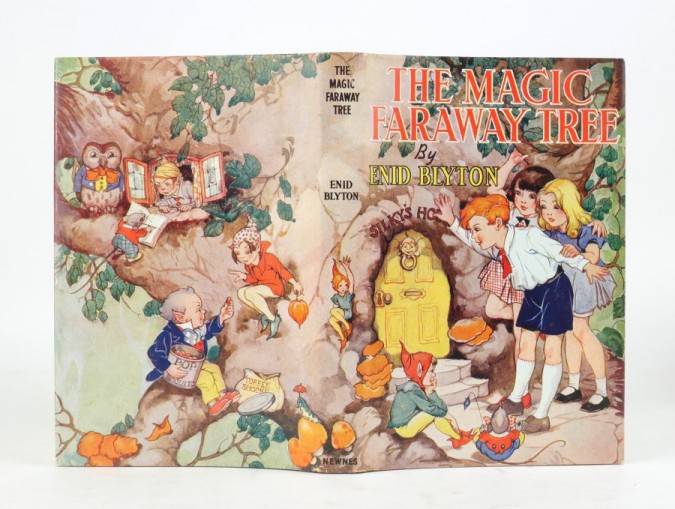
The wraparound dustwrapper design for The Magic Faraway Tree
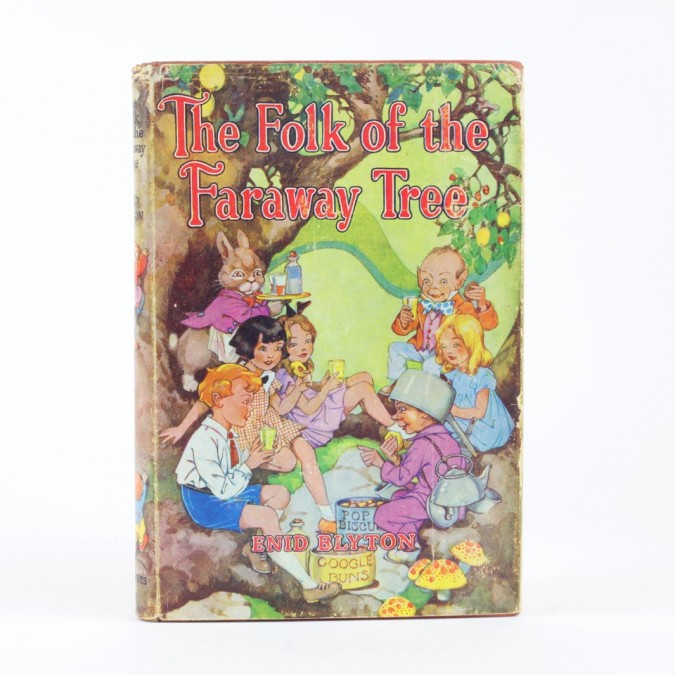
The Folk of the Faraway Tree, Dorothy Wheeler drawings
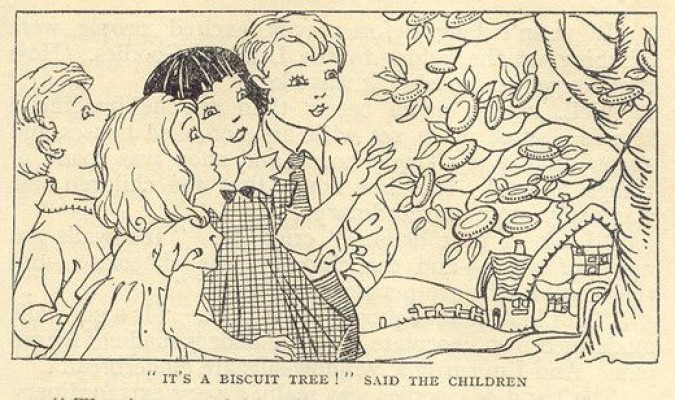
The Wishing Chair - Hilda McGavin
Also published by Newnes was another book of magical adventure The Adventures of the Wishing Chair, whose dustwrapper has a colour illustration by Hilda McGavin, which would make any child keen to leap aboard the winged chair. First published in 1937 first ediitons in original dustwrapper are extremely rare.
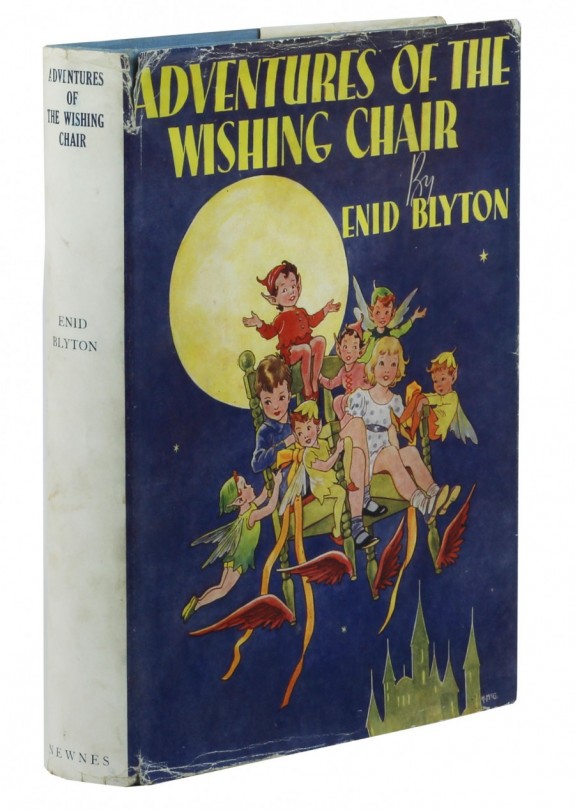
Adventures of the Wishing Chair, first edition dustwrapper artwork by Hilda McGavin
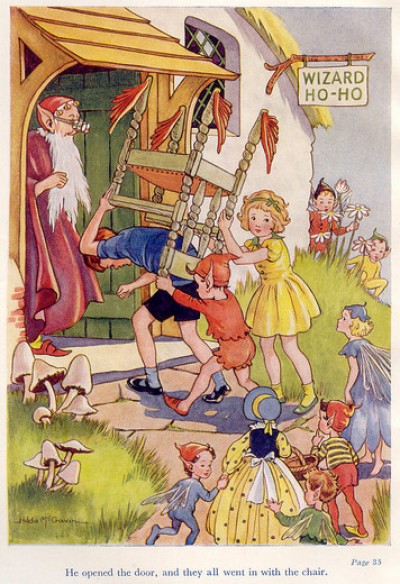
Hilda McGavin Frontispiece from Adventures of the Wishing Chair, 1937
The Secret Series – Various Illustrators
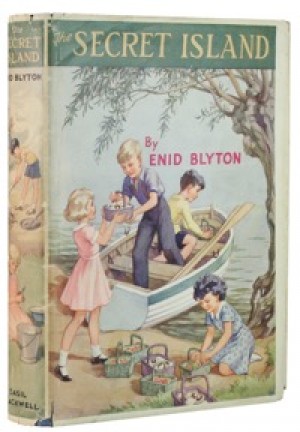
Blyton’s first full length children’s adventure story The Secret Island was published by Blackwell in 1938. It has a pictorial dustwrapper, colour frontis and line drawings by E.H. Davie; this is one of the most elusive of all the Blyton books in first edition and is very rarely encountered.
Further adventures in this series, used different artists. New Zealander, Harry Rountree, whose drawings added a burst of colour to books 2 and 3, The Secret of Spiggy Holes and The Secret Mountain. The fourth in the series, The Secret of Killimooin, had drawings by Eileen Soper and finally in 1953 The Secret of Moon Castle, with a slightly ‘cutesy’ cover design by Dorothy Hall.
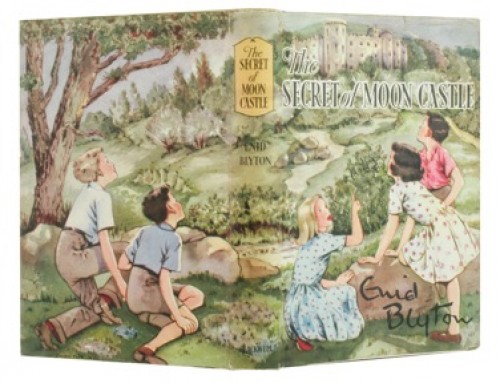
Dorothy Hall dustwrapper for the final book in the Secret Series
The Famous Five – Eileen Soper
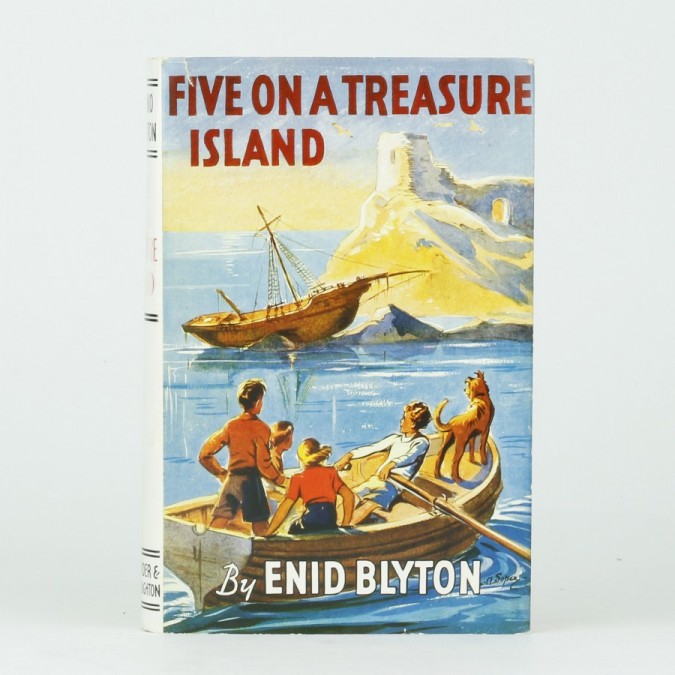
Published in 1942, Five on a Treasure Island, Dustjacket by Eileen Soper
In 1942 Enid Blyton introduced us to Julian, Dick, George, Anne and Timmy, more commonly known as “The Famous Five”. After a brief correspondence with Horace Knowles about the book, it was decided that his style was not right for an adventure story and Eileen Soper was chosen to provide a series of drawings. Her work perfectly captures the carefree spirit of the children, as they embark on their outdoor adventures and Blyton delighted in her style.
“I don’t need to see roughs of any of her sketches... I have always found her accurate and most dependable – in fact excellent in every way.”
Soper was to provide the illustrations for all 21 of the famous five stories, as well as working on a host of other projects with Blyton.
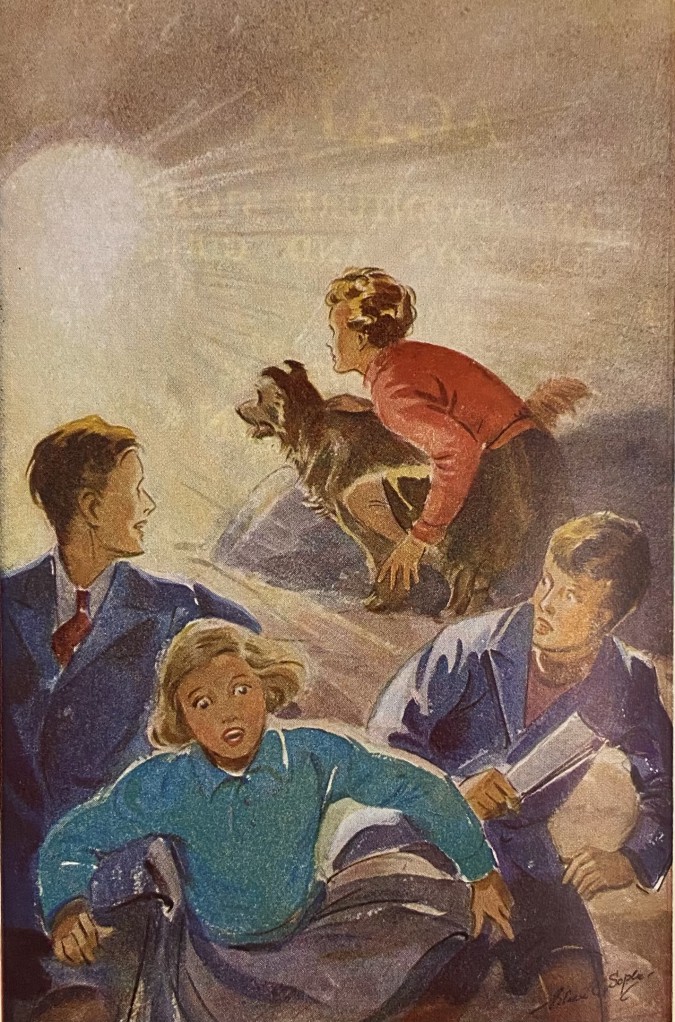
Frontispiece to Five Go Adventuring Again
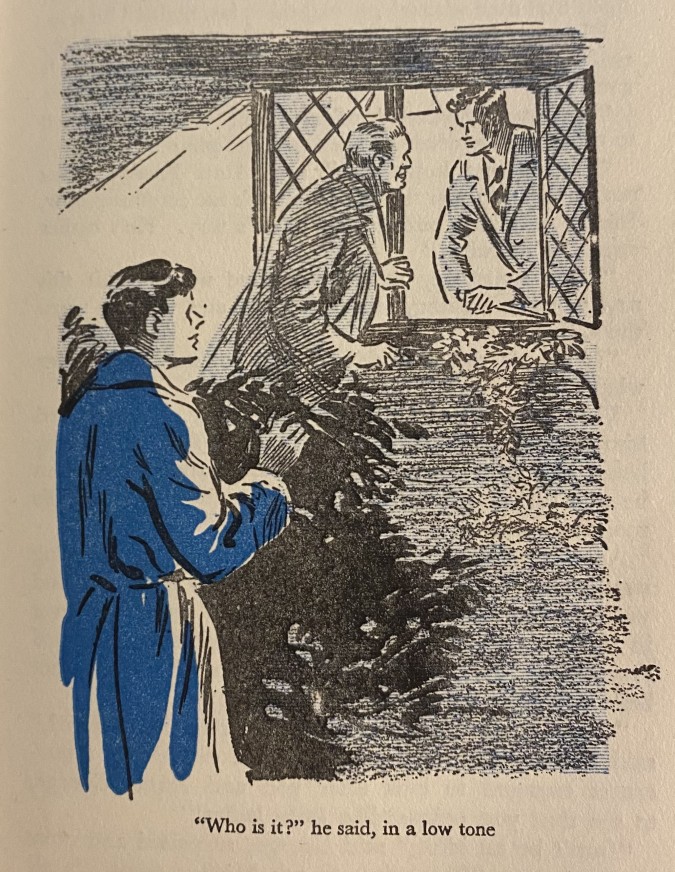
Eileen Soper full page illustrations in line with single colour overlay, Five Have Plenty of Fun
The School Stories: St Clare’s, Malory Towers and The Naughtiest Girl in the School
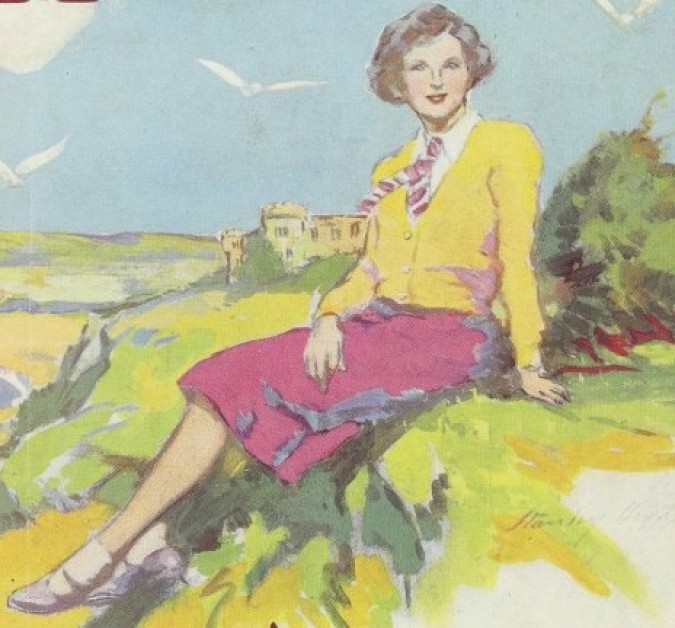
Many of Enid Blyton’s stories were based on her own or her daughter’s experiences, with school stories featuring snapshots of daily life gleaned from Gillian and Imogen , “games of hockey, lacrosse and tennis, the little spites and deceits of school life, the loyalty and generosities of friendship”. It is this inside knowledge which makes the stories so appealing to children to this day. Her school stories are full of midnight feasts, school politics, sports matches, exam nerves, successes and friction; as well as jokes made at the expense of eccentric teachers.
Blyton’s first school series sees the two ‘stuck-up’ twins, Isobel and Pat head off to St.Clare’s. There are six books in the St. Clare’s series, published between 1941 and 1945, all with illustrations provided by W. Lindsay Cable. Due to war time economies the paper stock used was fairly poor quality making it difficult to encounter first editions of the stories in their dustjackets, whose simplicity captures the war time period well.
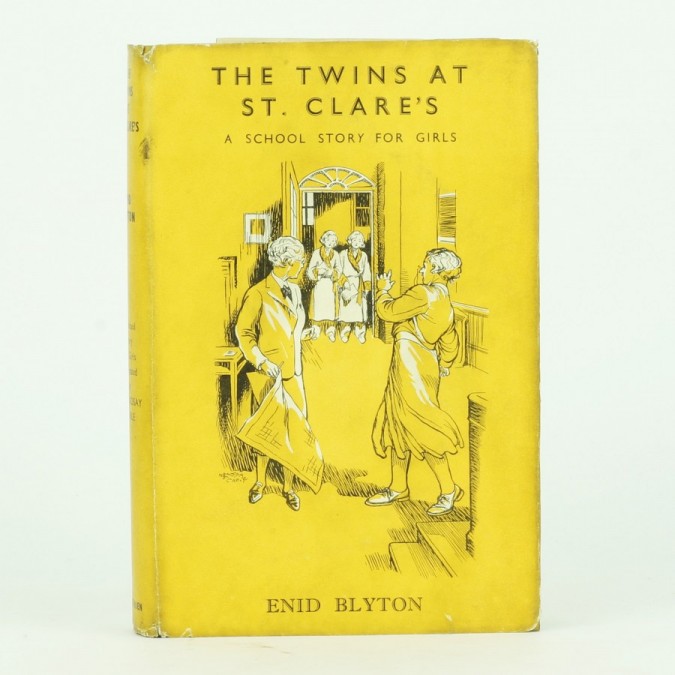
The Twins at St Clare's, first published 1941, W. Lindsay Cable dustjacket
Hot on the heels of the St. Clare’s stories came another six volume school series, The Malory Towers books. The same mix of fun and adventure continued, with a strong central character, Darrell Rivers and the wildly romantic setting of a Cornish cliff top, children’s imaginations were readily captured. Stanley Lloyd’s illustrations gave the books a more modern feel, dustwrappers depicted girls partaking in healthy outdoors pursuits, swimming in the rock pool or engaged in a tight fought lacrosse match. Many is the little girl who has longed to attend Malory Towers, draughty corridors notwithstanding.
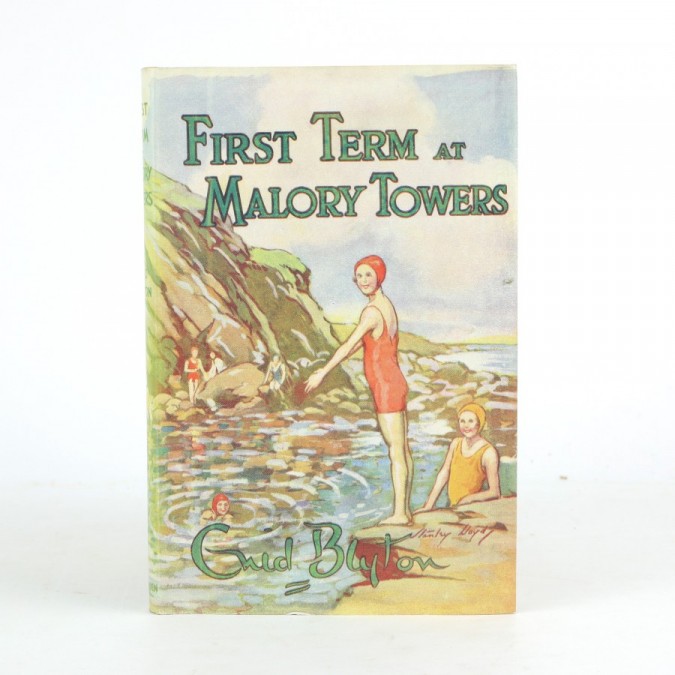
Stanley Lloyd's drawings depict the spirited modern young ladies of Malory Towers
A slightly different slant is seen in the portrayal of Elizabeth Allen, The Naughtiest Girl in the School, who begins as something of an anti-hero, spoilt, belligerent and incandescent with rage at being sent away to school. But Whytecliffe is no ordinary school, it’s progressive head mistresses, Miss Belle and Miss Best, handover discipline and decision making to the school council, overseen by the head boy and girl. Four books published between 1940 – 1945, with the first two having illustrations by W. Lindsay Cable and the latter by Kenneth Lovell.
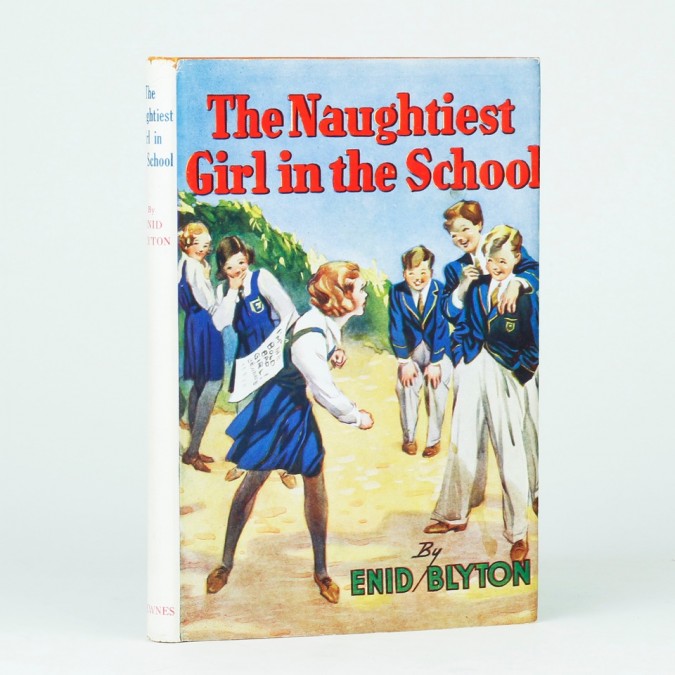
The Naughtiest Girl drawn by W. Lindsay Cable
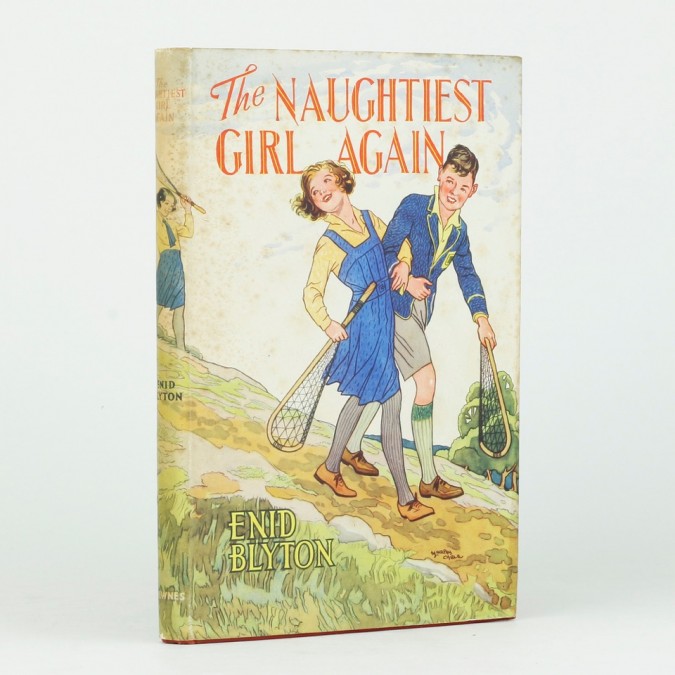
W. Lindsay Cable artwork for the second in the Naughtiest Girl series.
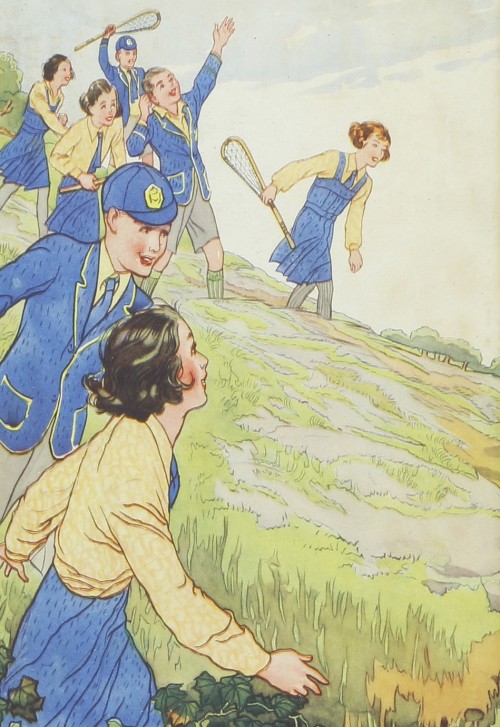
In this post I've highlighted just a few of the artists that worked with Blyton, some household names or well known illustrators, others less more unsung. There will be those who wonder how I could miss out their favourite stories, The Secret Seven, The Adventure Stories or Noddy, but those will have to be for another post.
Read more about Blyton and our current stock her work.
Comments
Recent Posts
- The Evolution of Crime
- Tour The Bookshop On Your Screen
- The Genesis of Mr. Toad: A Short Publication History of The Wind In The Willows
- Frank Hurley's 'South'
- The "Other" Florence Harrison
- Picturing Enid Blyton
- Advent Calendar of Illustration 2020
- Depicting Jeeves and Wooster
- Evelyn Waugh Reviews Nancy Mitford
- The Envelope Booklets of T.N. Foulis
- "To Die Like English Gentlemen"
- Kay Nielsen's Fantasy World
- A Brief Look at Woodcut Illustration
- The Wealth Of Nations by Adam Smith
- What Big Stories You Have: Brothers Grimm
- Shackleton's Antarctic Career
- Inspiring Errol Le Cain's Fantasy Artwork
- Charlie & The Great Glass Elevator
- Firsts London - An Audio Tour Of Our Booth
- Jessie M. King's Poetic Art, Books & Jewellery
Blog Archive
- January 2024 (1)
- January 2023 (1)
- August 2022 (1)
- January 2022 (1)
- February 2021 (1)
- January 2021 (1)
- December 2020 (1)
- August 2020 (1)
- July 2020 (2)
- March 2020 (3)
- February 2020 (2)
- October 2019 (2)
- July 2019 (2)
- May 2019 (1)
- April 2019 (1)
- March 2019 (2)
- February 2019 (1)
- December 2018 (1)
- November 2018 (1)
- October 2018 (2)
Dudley Chignall 05/Feb/2021 12:48
Ernest Aris illustrated for Enid. He was also commissioned to illustrate for Beatrix Potter but the tale was never published as there was some doubt as to its originality. https://collections.vam.ac.uk/item/O1315676/illustration-to-the-oakmen-drawing-aris-ernest/